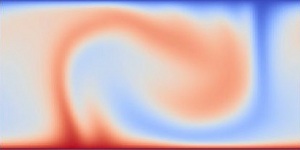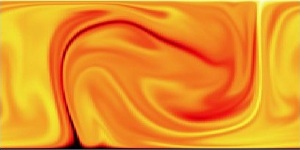|
|  |
Let’s do a little experiment: When you put hot coffee in a glass
- not in a mug, since you want to see what's happening inside the
liquid — the coffee cools at the top, sinks to the bottom, and
is replaced by rising hot fluid - this is called a convective
flow. (Side note: If you stir milk into your coffee, then the rising
and sinking pattern shows nicely — especially if the milk you
added was slightly off.)
If you add milk and do not stir the coffee, the flow pattern is
interrupted: the convection is not strong enough to lift the milk,
which is slightly heavier than water from the bottom of the
glass. However, this is not the end: after a few minutes one can
observe that thin layers have formed in the transition region between
the milk and the coffee (this works especially well with low-fat
condensed milk). Convection continues, but separately inside each of
the layers without larger-scale mixing. This phenomenon is called
double diffusive convection and occurs also in Nature, for example in
the Arctic Ocean, where cold fresh water under the ice sheet forms
layers above warm sea water, or in the volcanic lakes of East Africa.
Double diffusive convection can also occur in stars, which burn
hydrogen into helium at their cores. Here, the convection driven by
the heat from nuclear fusion is impeded by accumulating helium
'ashes'. The resulting layers interfere with the convective mixing of
helium outward — it more or less stays in the centre.
The detailed distribution of helium throughout the star, however, has
a strong impact on its further evolution. Over the long life of the
star, even minor amounts of mixing can become important. Therefore the
question of how much residual mixing might take place needs to be
investigated.
Scientists at the MPA have now measured this rate of mixing with an
extensive set of numerical simulations of the layering
phenomenon. Just like in the geophysical examples mentioned above, the
scientists found that the mixing of helium produced in nuclear
reactions inside the star is quite low, much lower than what is
usually assumed in theories of stellar evolution. Even over the star's
entire life time, its effects are probably negligible.
F. Zaussinger, H. Spruit
|





